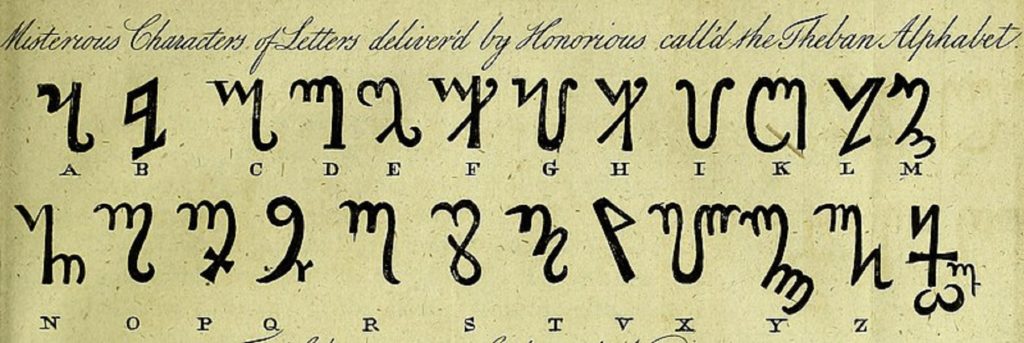
A few years ago I began to look into the history and use of the Theban alphabet which are also known as Witches Runes, Witch writing, Honorian alphabet and the Runes of Honorius. This form of cypher dates back to Medieval times and has been a used in Mysticism and magical practices ever since. In recent years I began making Theban divination sets and find it to be quite a intriguing type of divination. So today’s blog post will be covering all about this interesting alphabet.
The Origins of the Theban
The Witch’s alphabet dates back to the 14th Century and is also known as the Theban alphabet. Additionally it has been called the Honorian alphabet, Theban Script or the Runes of Honorius. It’s exact origin is unknown nor is it’s original creator. As it is with all undocumented ancient history, there is controversy surrounding the Witch’s alphabet. It’s mostly been attributed to Honorius of Thebes, a Middle Age figure shrouded in so much mystery that some consider his very existence to be a myth. Many students of the occult believe the Theban alphabet dates back much further, to before the 11th Century. That group claims it originated as an alchemical cipher with an Avestan influence. Avestan is oldest preserved Indo-Aryan language and it’s closely related to Vedic Sanskrit. But this counter-theory is also undocumented and thus un-provable.
However, there is evidence to be gleaned from the shape of the characters and corresponding curve patterns that define Theban. They show an unmistakable resemblance to characters found in the Avestan alphabet. This alone doesn’t prove a theory. There are major differences such as fewer characters and the inclusion in Theban of a symbol to denote the end of a sentence. Theban does not have an upper or a lower case, so that symbol was critical. Another comparison has been made with Latin. There is a one-to-one correspondence between letters of the Witch’s alphabet and Latin alphabets with the exception of the letters j and u. Those two letters are represented by the letters for i and v. The Theban alphabet has also been called a runic alphabet but it’s clearly not. Runes are characterized by straight lines and sharp edges, while the Theban alphabet is mostly based on arcs and curls. SOURCE
The first known recordings of the alphabet came from the astrologer Johannes Trithemius who included it in his 1518 published book Polygraphia. Trithemius stated the alphabet came from the Theban Honorius and it was revealed by Petries de Apono (aka Pietro D’Abano).
Heinrich Cornelius Agrippa studied under Johannes Trithemius. Agrippa started referring to this script as the Theban alphabet in his book Three Books of Occult Philosophy and said it was from Honorius of Thebes.
Since Petries de Apono was close with Pope Honorius IV, some believe him to be the source; or his granduncle, Pope Honorious III. However, there is no proof of this because there has not been any work from either of them that contains this alphabet, including the manuscript written by Pope Honorious III called Grimoire du Pape Honorius.
Another belief connects to the fourteenth-century manuscript The Sworn Book of Honorius authored by Honorius of Thebes. According to lore, Honorius of Thebes was a scribe who complied this information together during a large assembly of deeply knowledgable magical practitioners. However, this is still speculation because the only copy of The Sworn Book of Honorius that remains today states that the Theban alphabet’s origins are from Heinrich Cornelius Agrippa. SOURCE

Uses in Magick and Divination
With the exception of the letters J and U / V, this alphabet is a one to one substitution cipher. That means that each character of the Theban alphabet corresponds to one of the letters in the Latin alphabet.
That makes this alphabet very easy to use in your magic writings and other workings. It’s simple to switch one letter for another to obscure what you’re writing.
Especially when the Theban alphabet was created, the Christian church was doing its best to stamp out any ancient practices, paganism, or witchcraft. Writing in a script that couldn’t be translated allowed magicians and witches to record their work without fear of being killed by the church.
The Theban alphabet is popular among witches to give their writings a mystical quality and to hide the meaning of what they are writing. Wiccans and other witches have adopted many substitution ciphers to hide and obscure the contents of their books of shadows. SOURCE
The Theban alphabet can also be used in a similar way in divination like is done with Ogham and Elder Futhark Runes which you can learn more reading HERE and HERE.
In this book, author Greg Jenkins, PhD, offers both the complete history of this medieval magical system and a working manual for the modern mage to utilize it. In these pages, you’ll find:
• How to make and care for your own set of stones.
• A variety of methods for divination, from using just one stone to using nine stones and more.
• How to use the Theban stones for spellcasting, including love and purification spells and Theban incense and candle magick.
• A complete lexicon of the Theban alphabet with a who’s who of Theban history along with divinatory meanings and how they relate to the modern world.
• A quick reference to the sacred herbs and angelic orders associated with each symbol.
Prepare yourself to discover the hidden mysteries of the ancients and the magick within you.
In conclusion the Theban alphabet is one that can be used in a variety of ways for spiritual divination and witchcraft practices. It has a fascinating history with origins shrouded in mystery and has been a part of Occult and Mysticism for centuries. Today you can see it used for spells in Grimoires, Book of Shadow and more giving the Theban a practical use still to this day.
Further Resources
